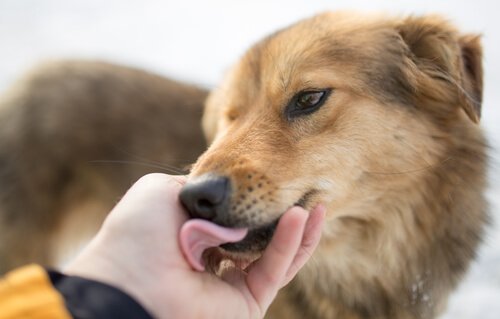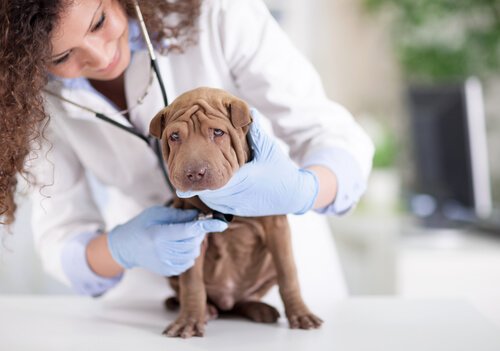Dogs Vomiting: Warnings and Treatment

Dogs throwing up is very common. But it’s important to take a series of precautions so they don’t vomit again. It could be nothing, however, something bad could be happening to your dog. In both cases, vomiting isn’t comfortable for your pet. Therefore, you should try to help them in order to take away their discomfort as soon as possible.
In this article, we will give you some advice on knowing taking care of your dog when they’re vomiting. Don’t miss out on a single detail. You may never know when you’re going to need them.
Taking care of dogs that are vomiting
You don’t need to be worried, if a good amount of time has gone by (a maximum of 2 days) and your dog is still throwing up, you should get them to a vet ASAP.
Until then, try your best to make them feel better.

- Don’t give them food for at least two hours after their first episode of vomiting. This will help relieve their digestive system.
- Water in small amounts: vomiting dehydrates dogs. Therefore, they need to drink water. They will need to be given small amounts. This is because if you give them too much, the water will get them to vomit again. So, instead of helping this makes the situation worse.
- Bland diet: if your dog has stopped vomiting for at least 6 hours, you can give them something to eat. When you do, it should be a food that’s lite on their stomach. It’s just like feeding a child who’s throwing up. The best thing to do is give them is a little rice and a little skinless, boneless, boiled chicken.
- Don’t give your dog medicine. Even if someone has recommended medication to give your dog, don’t trust them. A vet is the only one qualified to prescribe medications to your dog. Just because something worked for another animal doesn’t mean it’ll work for yours. Giving medication without a prescription might hurt your pet more.
- Add their food: after two days, see if the time between episodes of vomiting is longer. If so, you can start adding your dog’s normal food. You should start by giving your dog equal parts of soft food and regular food.
When vomiting becomes dangerous for your dog
There are times when throwing up can cause greater problems for your dog. You need to keep a close eye on them and their vomit. Here are several occasions in where you need to take immediate action:

- If you find plastic. If you find small pieces of plastic or a plastic bag in your dog’s vomit, take them immediately to the vet. This can cause an intestinal blood clot. This would cause greater problems for your dog.
- A strong smell. If your dog’s vomit gives off a chemical smell, it’s possible that they’ve eaten something that can do a lot of damage. If this happens, take them to the vet immediately.
- Blood. Don’t trick yourself into thinking that if you see blood that it’s because your dog forced himself so much that he hurt his throat in the process. Blood in their vomit is almost never a good sign.
- Too much saliva. Too much saliva is a sign that there’s a greater problem. While they’re vomiting and almost dehydrated, it’s not normal for any animal to produce so much saliva. As a result, you need to take them to a vet immediately.
- Dry heaving. They might experience ongoing dry heaving without throwing up anything. If so, it’s probably best to take them to a vet.
- If they want to throw up and can’t. This can happen when they have a gastric obstruction. This can get to the point where it cuts off the blood flow and causes necrosis.
- They reject food or water. If your animal isn’t accepting even a little water, take them to the vet asap. It’s possible that they have an internal problem that you don’t know about.
There are many things you can do at home to take care of your pet when they are throwing up. However, if you don’t find out why, you’re worried, or see something strange, go to the vet.
Dogs throwing up is very common. But it’s important to take a series of precautions so they don’t vomit again. It could be nothing, however, something bad could be happening to your dog. In both cases, vomiting isn’t comfortable for your pet. Therefore, you should try to help them in order to take away their discomfort as soon as possible.
In this article, we will give you some advice on knowing taking care of your dog when they’re vomiting. Don’t miss out on a single detail. You may never know when you’re going to need them.
Taking care of dogs that are vomiting
You don’t need to be worried, if a good amount of time has gone by (a maximum of 2 days) and your dog is still throwing up, you should get them to a vet ASAP.
Until then, try your best to make them feel better.

- Don’t give them food for at least two hours after their first episode of vomiting. This will help relieve their digestive system.
- Water in small amounts: vomiting dehydrates dogs. Therefore, they need to drink water. They will need to be given small amounts. This is because if you give them too much, the water will get them to vomit again. So, instead of helping this makes the situation worse.
- Bland diet: if your dog has stopped vomiting for at least 6 hours, you can give them something to eat. When you do, it should be a food that’s lite on their stomach. It’s just like feeding a child who’s throwing up. The best thing to do is give them is a little rice and a little skinless, boneless, boiled chicken.
- Don’t give your dog medicine. Even if someone has recommended medication to give your dog, don’t trust them. A vet is the only one qualified to prescribe medications to your dog. Just because something worked for another animal doesn’t mean it’ll work for yours. Giving medication without a prescription might hurt your pet more.
- Add their food: after two days, see if the time between episodes of vomiting is longer. If so, you can start adding your dog’s normal food. You should start by giving your dog equal parts of soft food and regular food.
When vomiting becomes dangerous for your dog
There are times when throwing up can cause greater problems for your dog. You need to keep a close eye on them and their vomit. Here are several occasions in where you need to take immediate action:

- If you find plastic. If you find small pieces of plastic or a plastic bag in your dog’s vomit, take them immediately to the vet. This can cause an intestinal blood clot. This would cause greater problems for your dog.
- A strong smell. If your dog’s vomit gives off a chemical smell, it’s possible that they’ve eaten something that can do a lot of damage. If this happens, take them to the vet immediately.
- Blood. Don’t trick yourself into thinking that if you see blood that it’s because your dog forced himself so much that he hurt his throat in the process. Blood in their vomit is almost never a good sign.
- Too much saliva. Too much saliva is a sign that there’s a greater problem. While they’re vomiting and almost dehydrated, it’s not normal for any animal to produce so much saliva. As a result, you need to take them to a vet immediately.
- Dry heaving. They might experience ongoing dry heaving without throwing up anything. If so, it’s probably best to take them to a vet.
- If they want to throw up and can’t. This can happen when they have a gastric obstruction. This can get to the point where it cuts off the blood flow and causes necrosis.
- They reject food or water. If your animal isn’t accepting even a little water, take them to the vet asap. It’s possible that they have an internal problem that you don’t know about.
There are many things you can do at home to take care of your pet when they are throwing up. However, if you don’t find out why, you’re worried, or see something strange, go to the vet.
This text is provided for informational purposes only and does not replace consultation with a professional. If in doubt, consult your specialist.








